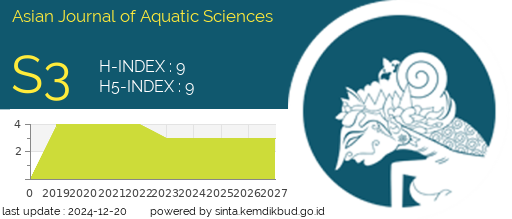EVALUATION OF WATER QUALITY AND GROWTH PERFORMANCE OF RED TILAPIA (Oreochromis sp) IN CULTURE USING BIOFLOCK TECHNOLOGY
DOI:
https://doi.org/10.31258/ajoas.7.2.305-311Keywords:
Survival Rate, Growth Performance, BioflocAbstract
Water quality plays an important role in maintaining and increasing fish production. Tilapia (Oreochromis niloticus) is one of Indonesia's freshwater fish that has economic value. To increase production, tilapia cultivation is carried out intensively, characterized by high stocking density and provision of protein-rich feed. Good water quality control and feeding are key to the success of this intensive culture. Biofloc technology is one of the appropriate technologies for intensive tilapia rearing since fish can live at high densities and have a wide environmental tolerance. Biofloc technology is an alternative solution to problems in overcoming cultivation waste such as ammonia and nitrite. Based on the above, this study was conducted to determine the effectiveness of the biofloc system in converting ammonia compounds, improving water quality in the aquaculture environment, and understanding the relationship between water quality and tilapia growth. The research was conducted for 60 days to measure several water quality parameters, namely temperature, dissolved oxygen, acidity (pH), and ammonia, and to observe the growth parameters of tilapia. The treatment applied in this study was the addition of probiotics in feed with four treatments and three replications. The results showed that the biofloc system's water quality is tolerant to tilapia growth. The best growth results in treatment A with each value of absolute weight 14.70±0.10d, absolute length 6.70 ± 0.10d, specific growth rate 3.87±0.01c, and survival rate 100±0.00b
Downloads
References
1. Andriani, P., Hamzah, M., Kurnia, A. Subtitusi Tepung Kedelai (Glycine Max) dengan Tepung Daun Kelor (Moringa oleifera) dalam Pakan terhdap Tingkat Kecernaan Pakan Ikan Nila (Oreochromis niloticus). Media Akuatika, 2022; 7(4): 204-205
2. Putra, A.N., Widanarni, W., Utomo, N.B.P. Growth Performance of Tilapia (Oreochromis niloticus) Fed with Probiotic, Prebiotic and Synbiotic in Diet. Pakistan Journal of Nutrition, 2015;14: 263‒268
3. Putra, I., Rusliadi, R,. Muhammad, F., Usman, M.T., Muchlisin, Z.A. Growth Performance and Feed Utilization of African Catfish Clarias gariepinus Fed a Commercial Diet and Reared in the Biofloc System Enhanced with Probiotic. F1000Research, 2017; 6:1545.
4. Ombong, F., Salindeho, I.R.N. Aplikasi Teknologi Bioflok (BFT) pada Kultur Ikan Nila (Oreochromis niloticus). Jurnal Budidaya Perairan, 2016; 4(2) : 17-19.
5. Nurhatijah, N., Muchlisin, Z.A., Sarong, M.A., Supriatna, A. Application of Biofloc to Maintain The Water Quality In Culture of Tiger Prawn (Penaeus monodon). AACLBioflux, 2016; 9(4): 923-928.
6. Surawidjaja, E.H. Akuakultur Berbasis-trophic level: Revitalisasi untuk Ketahanan Pangan, Daya Saing Ekspor, dan Kelestarian Lingkungan. Orasi Ilmiah Guru Besar Tetap Ilmu Akuakultur, 2006; p34.
7. Rakocy, J.E., Masser, P., Losordo, M., Thomas, M. Recirculating Aquaculture Tank Production Systems: Aquaponics Integrating Fish and Plantculture. Southern Regional Aquaculture Center, 2006; 159 pp.
8. De Schryver, P., Verstraete, W. Nitrogen Removal from Aquaculture Pond Water by Heterotrophic Nitrogen Assimilation in Lab-Scale Sequencing Batch Reactors. Bioresource Technology, 2009; 100: 1162-1167.
9. Avnimelech, Y. Carbon/Nitrogen Ratio as a Control Element in Aquaculture System. Aquaculture, 1999;176: 227-235.
10. Rohmana, D. Konversi Limbah Budidaya Ikan Lele, Clarias sp. menjadi Biomassa Bakteri Heterotrof untuk Perbaikan Kualitas Air dan Makanan Udang Galah, Macrobrachium rosenbergii. Sekolah Pasca Sarjana, Institut Pertanian Bogor, 2009; p64.
11. Pangabean, K.T., Sasanti, A.D., Yulisman, Y. Water Quality, Survival Rate, Growth, and Feed Efficiency of Tilapia with Biofertilizer Liquid in Water Media Rearing. Jurnal Akuakultur Rawa Indonesia, 2016; 4(1): 67-79.
12. Barus, T.A. Pengantar Limnologi Studi Tentang Ekosistem Air Daratan. USU Press. Medan, 2002.
13. Suryaningrum, F.A. Application Maintenance Technology Seed Biofloc on Tilapia (Oreochromis niloticus). Fisheries and Marine Resources Management Journal, 2014; 1(1).
14. Ebeling, J.M., Timmons, M.B., Bisogni, J.J. Engineering Analysis of the Stoichiometry of Photoautotrophic, Autotrophic and Heterotrophic Removal of Ammonia-Nitrogen in Aquaculture System. Aquaculture, 2006; 257: 346- 358
15. Kordi, K. Budi Daya Perairan. PT Citra Aditya Bakti. Bandung, 2009.
16. Effendi, H. Telaah Kualitas Air. Kanisius. Yogyakarta, 2003.
17. Maryam, S. Budidaya Super Intensif Ikan Nila Merah (Oreochromis sp.) dengan Teknologi Bioflok: Profil Kualitas Air, Kelangsungan Hidup, dan Pertumbuhan.. Fakultas Perikanan dah Ilmu Kelautan Institut Pertanian Bogor. Bogor, 2010.
18. Arief, M., Fitriani, N., Subekti, S. Pengaruh Pemberian Probiotik Berbeda pada Pakan Komersial terhadap Pertumbuhan dan Efisiensi Pakan Ikan Lele Sangkuriang (Clarias sp.) Jurnal Ilmiah Perikanan dan Kelautan, 2014; 6(1).
19. Sari, N.P. Komposisi Mikroorganisme Penyusun dan Kandungan Nutrisi Bioflok dalam Media Pemeliharaan Induk Ikan Nila (Oreochromis niloticus) dengan Aplikasi Teknologi Bioflok. Institut Pertanian Bogor, 2012.
20. Hermawan, T.E.S.A., Sudaryono, A., Prayitno, S.B. Pengaruh Pada Tebar Berbeda terhadap Pertumbuhan Kelulushidupan Benih Lele (Clarias gariepinus) dalam Media Bioflok. Journal of Aquaculture Management and Technology, 2014; 3(3): 35-42.
21. Noviana, P., Subandiyono, S., Pinandoyo, P. Pengaruh Pemberian Probiotik dalam Pakan Buatan terhadap Tingkat Konsumsi Pakan dan Pertumbuhan Benih Ikan Nila (Oreochromis niloticus). Journal of Aquaculture Management and Technology, 2014; 3(4): 183-190
22. Praditia, F.P. Pengaruh Pemberian Bakteri Probiotik melalui Pakan terhadap Pertumbuhan dan Kelangsungan Hidup Udang Windu (Paneus monodon). Fakultas Perikanan dan Ilmu Kelautan. Institut Pertanian Bogor, 2009; p42.







